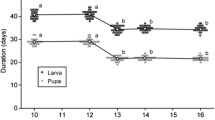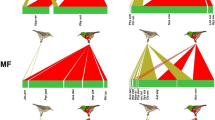Abstract
We studied the nutritional and reproductive response of Poecilus cupreus (synonymous with Pterostichus cupreus), one of the most abundant carabid beetles in arable land, to the succession in sixteen 1- to 4-year-old wildflower areas. A total of 390 male and 373 female beetles was examined. Each female was dissected and the number of ripe eggs counted. The nutritional state was expressed by a condition factor, which was calculated for each individual based on the observed weight and elytra length of male and female P. cupreus. Carabids in the 1-year-old wildflower areas contained significantly less ripe eggs than those from the 4-year-old areas. The condition factor of female and male beetles was significantly lower in 1- than 2- to 4-year-old areas. We examined the influence of habitat parameters (vegetation cover, soil water content, coarse and fine sand, pore volume, habitat size and age, surrounding landscape structure) on the reproductive success and nutritional state of P. cupreus in the 16 wildflower areas. The number of eggs was best explained by habitat age, accounting for 53.4% of the variability. The variation in the condition factor of female and male beetles was best explained by habitat age, which accounted for 73% and 71% of the variation, respectively. Moreover, the beetles' reproductive potential and nutritional condition were significantly associated with vegetation cover, and occasionally also with soil water content. The potential of wildflower areas as a reservoir for the generalist predator P. cupreus was shown to increase with successional age.




Similar content being viewed by others
References
Balmer O, Erhardt A (2000) Consequences of succession on extensively grazed grasslands for Central European butterfly communities: rethinking conservation practices. Conserv Biol 14:746–757
Bazzaz FA (1996) Plants in changing environments: Linking physiological, population, and community ecology. Cambridge University Press, Cambridge
Begon ME, Harper JL, Townsend CR (1996) Ecology, 3rd edn. Blackwell Science, Oxford
Bohan DA, Bohan AC, Glen DM, Symondson WOC, Wiltshire CW, Hughes L (2000) Spatial dynamics of predation by carabid beetles on slugs. J Anim Ecol 69:367–379
Bommarco R (1998a) Reproduction and energy reserves of a predatory carabid beetle relative to agroecosystem complexity. Ecol Appl 8:846–853
Bommarco R (1998b) Stage sensitivity to food limitation for a generalist arthropod predator. Environ Entomol 27:863–869
Bommarco R (1999) Feeding reproduction and community impact of a predatory carabid in two agricultural habitats. Oikos 87:89–99
Brown VK, Hyman PS (1986) Successional communities of plants and phytophagous Coleoptera. J Ecol 74:963–975
Brown VK, Southwood TRE (1987) Secondary succession: patterns and strategies. In: Gray AJ, Crawley MJ, Edwards DJ (eds) Colonization, succession and stability. Blackwell, Oxford, pp 315–337
Cardwell C, Hassall M, White P (1994) Effects of headland management on carabid beetle communities in Breckland cereal fields. Pedobiologia 38:50–62
Denys C, Tscharntke T (2002) Plant-insect communities and predator-prey ratios in field margin strips, adjacent crop fields, and fallows. Oecologia 130:315–324
Dijk TS van (1983) The influence of food and temperature on the amount of reproduction in carabid beetles. In: Brandmayer P, den Boer PJ, Weber F (eds) Ecology of carabids: the synthesis of field study and laboratory experiment. Report of the Fourth Meeting of European Carabidologists, 24–26 September 1981. Rothenberge, Westphalia, Germany, pp 105–123
Dijk TS van (1986) On the relationship between availability of food and fecundity in carabid beetles: how far is the number of eggs in the ovaries a measure of the quantities of food in the field? In: den Boer PJ, Grüm L, Szysko J (eds) Fifth meeting of European carabidologists at Stara Brda Pilska. Warsaw Agricultural University Press, Warsaw, pp 105–121
Dijk TS van (1994) On the relationship between food, reproduction and survival of two carabid beetles: Calathus melanocephalus and Pterostichus versicolor. Ecol Entomol 19:263–270
Frank T (1997) Species diversity of ground beetles (Carabidae) in sown weed strips and adjacent fields. Biol Agric Hortic 15:297–307
Günter M (2000) Anlage und Pflege von mehrjährigen Buntbrachen unter den Rahmenbedingungen des schweizerischen Ackerbaugebietes. Agrarökologie 37:1–154
Holopainen JK, Bergman T, Hautala E-L, Oksanen J (1995) The ground beetle fauna (Coleoptera: Carabidae) in relation to soil properties and foliar fluoride content in spring cereals. Pedobiologia 39:193–206
Huston M, Smith T (1987) Plant succession: life history and competition. Am Nat 130:168–198
Juliano SA (1986) Food limitation of reproduction and survival for populations of Brachinus (Coleoptera: Carabidae). Ecology 67:1036–1045
Koch K (1989) Die Käfer Mitteleuropas, vol 1. Ökologie. Goecke and Evers, Krefeld
Kromp B (1999) Carabid beetles in sustainable agriculture: a review on pest control efficacy, cultivation impacts and enhancement. Agric Ecosyst Environ 74:187–228
Künzle I (2002) Early succession of bug communities (Insecta: Heteroptera) on wildflower areas. Diploma thesis. University of Bern
Le Cren ED (1951) The length-weight relationship and seasonal cycle in gonad weight and condition in the perch (Perca fluviatilis). J Anim Ecol 20:201–219
Luff ML (1987) Biology of polyphagous ground beetles in agriculture. Agric Zool Rev 2:237–278
Lys J-A, Zimmermann M, Nentwig W (1994) Increase in activity density and species number of carabid beetles in cereals as a result of strip-management. Entomol Exp Appl 73:1–9
Mosimann C (2002) Diversity of ground beetles (Coleoptera: Carabidae) in relation to habitat age. Diploma thesis. University of Bern
Nelemans MNE (1987) On the life-history of the carabid beetle Nebria brevicollis (F.). Neth J Zool 37:26–42
Nentwig W (2000) Die Bedeutung von streifenförmigen Strukturen in der Kulturlandschaft. In: Nentwig N (ed) Streifenförmige ökologische Ausgleichsflächen in der Kulturlandschaft: Ackerkrautstreifen, Buntbrache, Feldränder. Agrarökologie, Bern, pp 11–40
Östman Ö, Ekbom B, Bengtsson J, Weibull A-C (2001) Landscape complexity and farming practice influence the condition of polyphagous carabid beetles. Ecol Appl 11:480–488.
Pearson D, Knisley CB (1985) Evidence for food as limiting resource in the life cycle of tiger beetles (Coleoptera: Cicindelidae). Oikos 45:161–168
Powell W, Dean GJ, Dewar A (1985) The influence of weeds on polyphagous arthropod predators in winter wheat. Crop Prot 4:298–312
Reichhart B (2001) Überwinterung von Käfern (Coleoptera: Carabidae, Staphylinidae) in unterschiedlich alten Buntbrachen. Diploma thesis. University of Bern
Renner M (1984) Kükenthal's Leifaden für das zoologische Praktikum, 19th edn. Fischer, Stuttgart
Siemann E, Haarstad J, Tilman D (1999) Dynamics of plant and arthropod diversity during old field succession. Ecography 22:406–414
Sokal RR, Rohlf F (1995) Biometry, 3rd edn. Freeman, New York
Sota T (1985) Limitation of reproduction by feeding condition in a carabid beetle, Carabus yaconinus. Res Popul Ecol 27:171–184
Speight MR, Lawton JH (1976) The influence of weed-cover on the mortality imposed on artificial prey by predatory ground beetles in cereal fields. Oecologia 23:211–223
SPSS 10 (2000) SPSS 10 Einführung in die moderne Datenanalyse unter Windows, 7th edn. Addison-Wesley, München
Sunderland KD, Vickerman GP (1980) Aphid feeding by some polyphagous predators in relation to aphid density in cereal fields. J Appl Ecol 17:389–396
Symondson WOC, Glen DM, Ives AR, Langdon CJ, Wiltshire CW (2002) Dynamics of the relationship between a generalist predator and slugs over five years. Ecology 83:137–147
Thiele H-U (1977) Carabid beetles in their environments. Springer, Berlin Heidelberg New York
Thies C, Tscharntke T (1999) Landscape structure and biological control in agroecosystems. Science 285:893–895
Thomas CFG, Parkinson L, Griffiths GJK, Fernandez Garcia A, Marshall EJP (2001) Aggregation and temporal stability of carabid beetle distributions in field and hedgerow habitats. J Appl Ecol 38:100–116
Tilman D (1990) Constraints and tradeoffs: towards a predictive theory of competition and succession. Oikos 58:3–15
Tramer EJ (1975) The regulation of plant species diversity on an early successional old-field. Ecology 56:905–914
Ullrich K (2001) The influence of wildflower strips on plant and insect (Heteroptera) diversity in an arable landscape. PhD thesis. ETH Zürich
Wallin H, Chiverton BS, Ekbom BS, Borg A (1992) Diet, fecundity and egg size in some polyphagous predatory carabid beetles. Entomol Exp Appl 65:129–140
Wise DH (1979) Effects of an experimental increase in prey abundance upon reproductive rates of two orb-weaving spider species (Araneae: Araneidae). Oecologia 41:289–300
Zangger A, Lys J-A, Nentwig W (1994) Increasing the availability of food and the reproduction of Poecilus cupreus in a cereal field by strip-management. Entomol Exp Appl 71:111–120
Acknowledgements
We thank S. Bacher, D. A. Bohan, E. Fournier, W. O. C. Symondson and two anonymous referees for critical comments on the draft version of the manuscript. Further thanks to C. Mosimann who collected the beetles in the field. M. Barone was paid by the Swiss National Science Foundation (project no. 3100–055482).
Author information
Authors and Affiliations
Corresponding author
Rights and permissions
About this article
Cite this article
Barone, M., Frank, T. Habitat age increases reproduction and nutritional condition in a generalist arthropod predator. Oecologia 135, 78–83 (2003). https://doi.org/10.1007/s00442-002-1175-2
Received:
Accepted:
Published:
Issue Date:
DOI: https://doi.org/10.1007/s00442-002-1175-2




